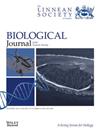可能的“银勺”效应对红树林河鱼(Kryptolebias marmoratus)成鱼陆地跳跃的影响(鲤形目:河鱼科)
IF 1.5
3区 生物学
Q3 EVOLUTIONARY BIOLOGY
引用次数: 0
摘要
在复杂环境中的生存依赖于整个动物的性能,这是自然选择和性选择的目标。由早期生活经历驱动的表型可塑性可以扩大成熟个体之间全动物性能的差异。因此,如果我们想要了解全动物生产性能的进化,那么详细了解影响表型可塑性的环境因素以及由这些环境因素控制的相关表型反应是必不可少的。在这里,我们利用在“普通花园”中饲养的雌雄同体红树林河流鱼(Kryptolebias marmoratus)建立的等基因系,研究了成年陆地跳跃性能的变化与早期生活经历(即卵密度)之间的联系。首先,我们假设来自不同等基因谱系的个体在跳跃表现上的差异与卵密度无关,这表明变异有严格的遗传来源。其次,我们假设表型可塑性也会导致成人跳跃表现的变化。具体来说,我们预计在早期发育中卵密度较高的雏鸟在成年后应该具有更好的跳跃性能,因为较高的卵密度可能预示着在孵化时更大的种内竞争。本文章由计算机程序翻译,如有差异,请以英文原文为准。
Possible ‘silver-spoon’ effect on adult terrestrial jumping in the mangrove rivulus fish (Kryptolebias marmoratus) (Cyprinodontiformes: Rivulidae)
Survival in complex environments is dependent on whole-animal performance, a target of natural and sexual selection. Variation in whole-animal performance among mature individuals can become broadened by phenotypic plasticity driven by early life experiences. Thus, detailing the environmental factors that contribute to phenotypic plasticity, and the associated phenotypic responses governed by those environmental factors, is essential if we are to understand the evolution of whole-animal performance. Here, using isogenic lines established from the hermaphroditic mangrove rivulus fish (Kryptolebias marmoratus) housed in a ‘common garden’, we investigate the link between variation in adult terrestrial jumping performance and early life experience (i.e. egg density). First, we hypothesize that individuals from different isogenic lineages should vary in jumping performance independent of egg density, suggesting a strict genetic source of variation. Second, we hypothesize that phenotypic plasticity should also introduce variation in adult jumping performance. Specifically, we expect that hatchlings incubated at higher egg densities in early development should adopt better jumping performances as adults, because higher egg density might be a cue for greater intraspecific competition upon hatching.
求助全文
通过发布文献求助,成功后即可免费获取论文全文。
去求助
来源期刊
CiteScore
4.30
自引率
10.50%
发文量
140
审稿时长
3-6 weeks
期刊介绍:
The Biological Journal of the Linnean Society is a direct descendant of the oldest biological journal in the world, which published the epoch-making papers on evolution by Darwin and Wallace. The Journal specializes in evolution in the broadest sense and covers all taxonomic groups in all five kingdoms. It covers all the methods used to study evolution, whether whole-organism or molecular, practical or theoretical.d.

 求助内容:
求助内容: 应助结果提醒方式:
应助结果提醒方式:


